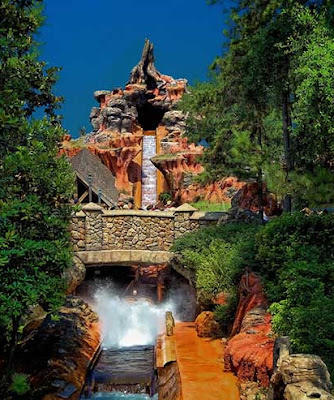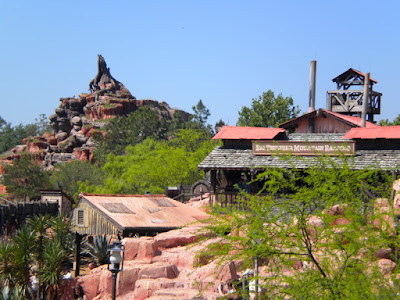How To Misplace A Mountain
This one's tough to talk about, because Splash Mountain is a Magic Kingdom classic and deserves a place in that park, as do Br'er Rabbit, Br'er Fox, and Br'er Bear. It's wildly popular, well designed, and is still - still - a major headliner attraction at the park.
But it just doesn't fit there.

Consider for a moment the disjunction between the homespun aesthetic of Splash Mt and the rustic river town of Frontierland. Frontierland is frontier men and fur trappers; Splash Mountain is a homespun quilt. There's a few attempts to blend it into the environment - many of the tunnels are now mine shafts and the music has a "bluegrass" twang to it - but the more you notice it the more and more apparent it is that the design team on this ride was just destined to get clobbered trying to fix the problem.
Splash Mountain gets in through a side door, I think, thanks to the fact that Country Bear Jamboree already existed in the area, and being descended from Marc Davis designs for America Sings and Song of the South, Splash Mountain fits in
just enough to not seem like a gross contradiction. Until you realize that the red Georgia clay of the mountain is down south, not old west, and the romantic South isn't "Frontierland" no matter
how you try to define it.
What elevates a poor thematic placement into the top five is that it makes mince of the careful architectural and conceptual progression of Magic Kingdom's river district, the true heart and most accomplished area of the park.
Liberty Square sweeps from upper New England (The Haunted Mansion) down through Philadelphia and Virginia (The Hall of Presidents) before heading west and transitioning to Frontierland at St. Louis (The Diamond Horseshoe). It then proceeds through the frontier territories, perhaps Kansas and Colorado, before arriving at cowboy vernacular architecture (Pecos Bill Cafe), then heading direct for the great Southwest pueblo architecture and monument valley (Big Thunder Mountain). This means that Splash Mountain's "deep south" is inserted directly into the section of the progression which once had a unified southwest and desert rock look. Lots of trees and an orange-red color help ease the intrusion, but an intrusion it indeed is.
The progression, of course, was intended from the start and would have ended with
Thunder Mesa instead of Big Thunder Mountain, but of course Big Thunder was designed to replicate the sort of rock work we would have had surrounding Western River Expedition, so the careful progression was retained into the early 90s.

Just as unfortunate, Splash Mountain is out of scale for Frontierland. This part of the park was designed to sit on a lower elevation than Adventureland and by the time the facades ramble out towards Pecos Bill, they were originally quite short. The need to have the pedestrian path cross over the main drop of Splash Mountain means that a large hill was added at the end of the street, spoiling the forced perspective of the Pecos Bill facades until they were rebuilt at double height a few years later. More significantly, the elevated view of Big Thunder Mountain from the top of the Splash Mountain hill steps on the forced perspective of Big Thunder Mountain, which originally rose gracefully at the end of the otherwise flat Frontierland area like a beacon and looked absolutely colossal.
Really the only upside of Splash Mountain's placement is the absolutely terrific views of Liberty Square and Cinderella Castle from the top of the main lift hill and pedestrian bridge. That's the reason why it's there, and it's understandable and obvious. Of course, we can ask if the view of the castle is
really all that important - Disneyland's faces some trees and, far away, the Matterhorn, and Tokyo has a general view of Westernland, and nobody thinks that there's something seriously missing when they ride those versions of the ride.
In many ways this is a tough call because the spot it was built is really the only place in Magic Kingdom it could have realistically went without building a self-contained Critter Country, which of course could not be directly on the big river, an important feature. Still, if I could move that mountain to an equally appropriate place in the park, I would.
The gorgeous stretch of land between Country Bear Jamboree and Thunder Mountain, with spreading trees, flowers, and split-rail fence, was one of the few areas in that Frontierland to feel genuinely rustic. And it seems to be a shame to lose that beautiful original train station, and that sense of a town way out on the edge of nothing, in the bargain.